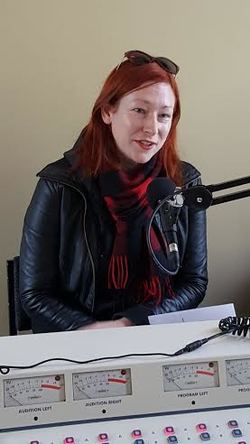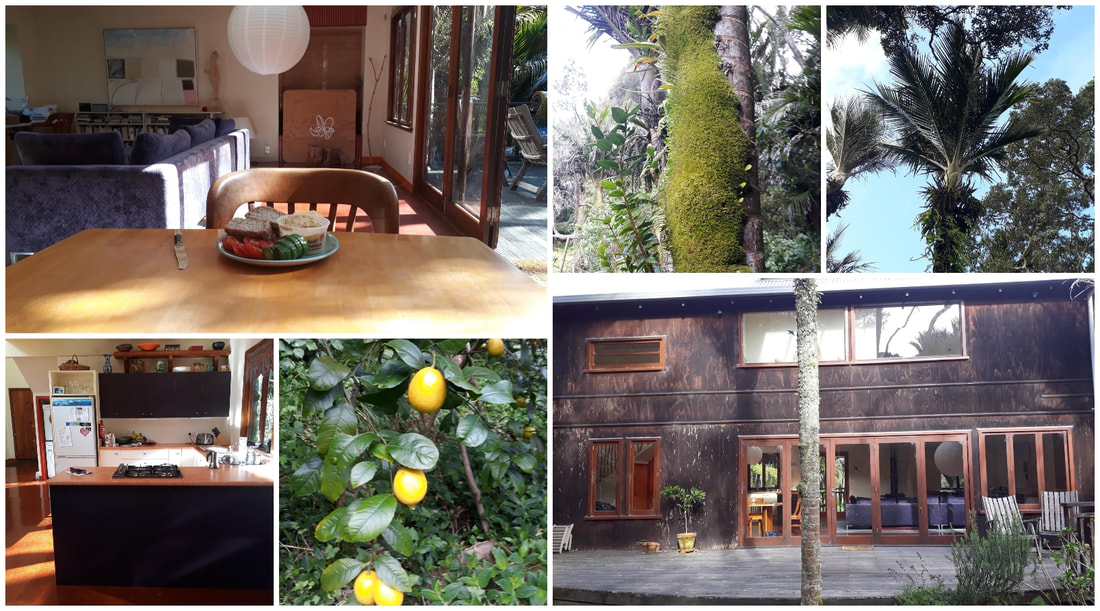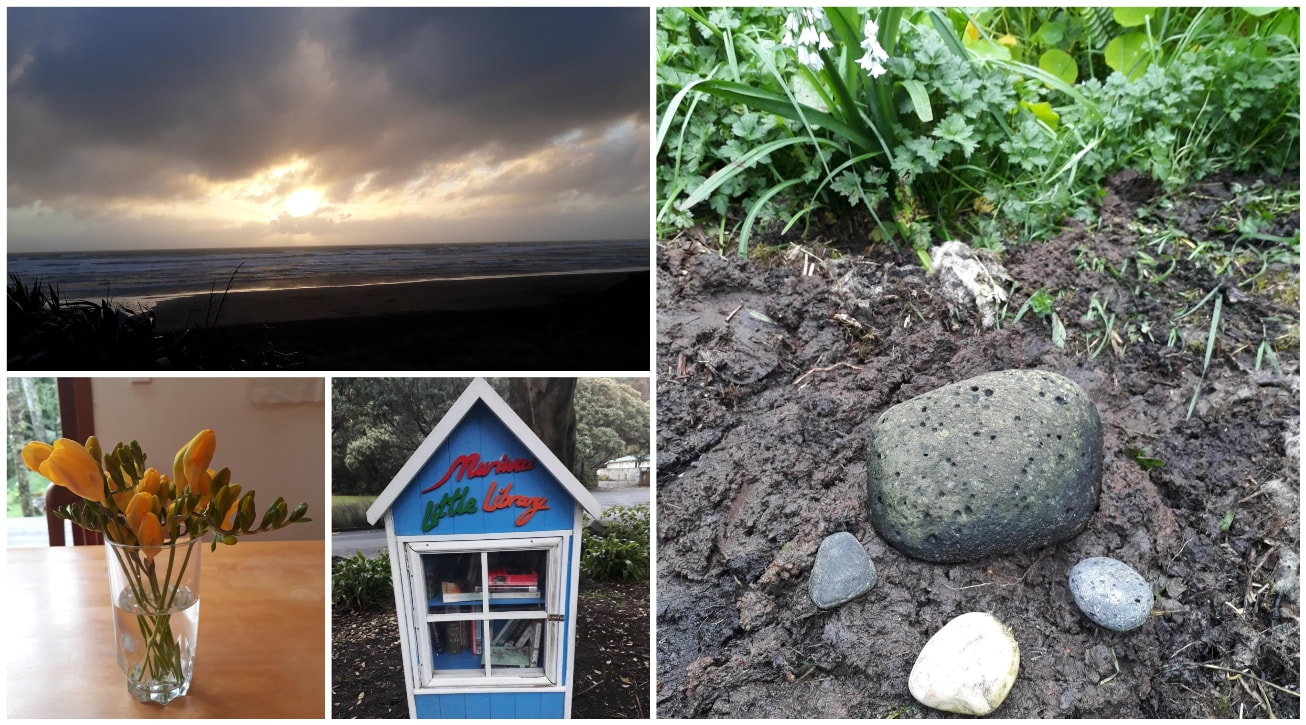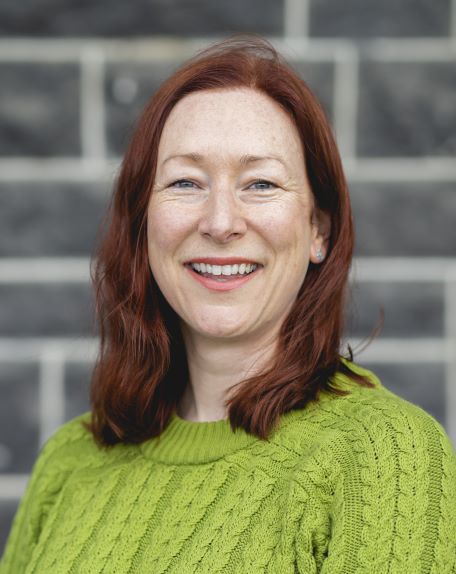|
I've popped over the ditch to experience the Sydney winter for a couple of weeks (it's not dissimilar to the Dunedin summer!). I'm staying at Eramboo Artist Environment, which is a wonderful facility in Terrey Hills, near Sydney's northern beaches. I can't get over the incredible variety of birds here - and the incredible variety of creepy crawlies! Apparently the artists share this space with a goanna and a python, along with a magnificent kookaburra, a friendly butcherbird, several intrepid bush turkeys and the ever-present cockatoos.
While I'm here I'm completing the final short story for my collection, Pet. I'll also polish up a couple of older stories, and do a couple of other writing tasks too. I was the 2018 recipient of the Creative Hub / Earthskin Retreat writer’s residency. Here’s how I made the residency work for me … and why you should definitely consider applying.
I stomped along Back Beach Road next to my husband, mud flying like spittle as I vented my spleen. ‘Residencies are so stupid!’ I complained. ‘Six months in a cold house somewhere with a tiny stipend? That only suits people who are independently wealthy or already broke. What are people with jobs supposed to do? Quit?’ ‘Mmmm,’ said my husband, who had heard this rant before. ‘What should we do for dinner tonight?’ Not long afterwards, an email from The Creative Hub arrived in my inbox. ‘New Hub residency in Muriwai beauty spot,’ said the subject-line. ‘Another stupid residency,’ I thought. But I clicked anyway. ‘The residency will take place for the month of September 2018, and is open to anyone who has completed a Creative Hub writing course,’ the email said. ‘A month?’ I thought. ‘A month! That might just be do-able!’ And so, I applied. I figured my chances of being accepted were low ... to low to worry about working out the logistics. A while later, I received another email from The Creative Hub. ‘This email is to congratulate you on being the successful applicant for the 2018 September Earthskin / Creative Hub Muriwai Residency,’ it said. ‘OMG!’ I replied, in my finest prose. Time to work out those logistics! Q: How do I get the time? A: Hustle. A month is a wonderful, practical period of time for a residency – long enough to get stuck into a project, but short enough that if you have a job or other commitments, you can probably work the residency around them. In my case, I would normally have been able to take annual leave, but I had already booked my first-ever trip to Europe, and I wasn’t about to cancel that. Luckily my boss let me cobble together an arrangement whereby I took some annual leave, wrangled some study leave, and also worked remotely for a couple of hours each afternoon. (Working remotely was actually a useful tether to the outside world.) I’m based in Dunedin, but someone with family commitments who lived in Auckland might be able to use the space more like an office – staying there during the week and returning home during the weekends. If you think you might require extra flexibility, why not drop the Creative Hub an email and ask some questions before making your application. What’s the worst that could happen? Q: What do I do with the time? A: Spend it wisely. I made a time management plan before I arrived. My weekday routine was to get up at seven, do some pilates, have breakfast, and then write until at least midday with as much coffee as I wanted, but absolutely no internet. Then I had lunch, did my office work, and spent the rest of the afternoon reading, hanging out with the resident chicken, and going for a walk through the forest and down to the beach. After dinner I revised drafts, wrote blog posts and worked on illustrations for the next Bruce the Cat book. Weekends were a bit looser. I spent one weekend at the National Writers Forum, one weekend hosting a writing retreat for my Creative Hub cohort, and one holding a ‘show and tell’ at Earthskin Retreat and catching up with friends. Over the past couple of years I’ve read a lot about the routines of other writers, and most seem to write productively for three to five hours per day. Going into the residency, that was useful information to know – otherwise I might have flagellated myself trying to write all hours of the day and night. Having time up my sleeve for thinking, reading and revising was more useful than spending every waking hour at my keyboard. Q: What is Earthskin Retreat in Muriwai like? A: Glorious. Earthskin Retreat is a two-storey house nestled in amongst native bush. On a sunny day it’s toasty warm, and on a gloomy day there’s a fireplace to keep things cheerful. (Pro tip: bring slippers!) Muriwai itself is an inspiring spot. Living at Earthskin is like living in an aviary. (Pro tip: bring your camera!) The beach and the café are a short walk from Earthskin, and there’s also a dairy and takeaway shop just down the road. Q: What should I work on? A: Something you’ve thought about before you get there. In 2015 I undertook a two-week, self-funded residency at The NZ Pacific Studio, and while it was a great experience, I didn’t come away with a lot of decent work. I think that’s because I didn’t have a clear idea about what I wanted to achieve when I went into it. This time around, I had just completed a funding application for a collection of short stories. The application was ultimately unsuccessful, but the work I put into it set me up to make the most of the residency. By the time I got to Muriwai I already had an overarching project (the collection of short stories), a title with multiple facets of meaning (Pet), and outlines for several stories. The first story I wrote just poured out. Q: What will the outcomes of the residency be? A: Whatever you decide they’ll be … plus a bit more. I made a list of things I wanted to achieve during the residency. I knew I would end up deviating from the plan, but I also knew that having a rough map would help me stay on task. The list was:
In the end, I only completed one Bruce the Cat drawing. On the up-side, I wrote far more than two short story drafts. The first story I wrote, Emotional Support Animal, went on to come third in the Sunday Star-Times Short Story Competition. (The first and second place winners, Fiona Sussman and Eileen Merriman, are also Creative Hub graduates!) I wrote a piece of flash fiction that I'm really proud of, and I've just put the finishing touches on two other short stories I started on the residency. I also have a couple of other rough drafts ready to pull out and polish up. (And I wrote a couple of a real turds that ended up in the Earthskin Retreat fireplace. What a satisfying way to dispose of bad writing!) Beyond those tangible outcomes, I also had much more time to think than I do in my daily life. All that walking and thinking has enriched my writing and deepened my short story ideas. And of course, being selected to undertake the residency was a real boost to my confidence, and a big stride along my writing journey. Q: Should I apply? A: Yes! I skipped along Back Beach Road next to my husband, wildflower petals swirling in the warm air around us like confetti. ‘I’ve been thinking about this Sunday Star-Times thing,’ I said. ‘It really all stems from The Creative Hub. Doing the course, and staying connected with such a great cohort of people, and then getting the residency.’ ‘Mmmm,’ said my husband, who had heard about nothing but the Sunday Star-Times Short Story Competition for days. ‘What should we do for dinner?’ More details How to apply The Creative Hub / Earthskin Retreat residency is open to anyone who has completed a Creative Hub writing course. Applications close on 20 February 2019. Email [email protected] for details. Earthskin Retreat Visit the Earthskin Retreat website to learn more about the facilities. The Creative Hub Visit The Creative Hub website to learn more about the writing courses that are offered both in-person and online. I'm sitting beside a glowing fire, the wind and a maniacal hound howling outside, my jeans still muddy from the grave I dug earlier.
Yesterday I arrived in Auckland to take up a month-long creative residency at Earthskin Retreat. Little did I know as I picked up my rental car that I would soon be caught up in a murder mystery. I drove confidently through the Waterview Tunnel, marvelling at the feat of engineering and at the blinding sea as I hurtled from the channel's depths. I drove semi-confidently to Kumeu, where I picked up some groceries from a supermarket with clientele so moneyed that the price labels are typed in 'who reads this anyway' 4 point font. I drove somewhat less confidently through winding bush-lined streets to Muriwai Beach and I white-knuckled it down an almost vertical driveway. It didn't look like a murder scene. It looked like a gorgeous, sun-filled home surrounded by Nikau palms and cabbage trees. I lit the fire in a personal best of thirty minutes and spent the evening unpacking, looking for the chickens and finishing The New Animals. In retrospect, the fact that I was reading a dystopian novel that features a crazed dog was somewhat foreshadowing. That, and the fact that I couldn't find the chickens. In the morning I started as I mean to go on by rising early and doing Pilates for Beginners. I've been following along to this DVD for about six years and I still haven't moved up to intermediate level. As I was getting stuck into some writing a local man called Robin stopped by to tell me more about the property. He arrived with a bunch of yellow freesias and a bouquet of stories. Robin's in his 80s, but he's got three kids in their early teens to keep him young. In between tales of his Antarctic adventures, the challenges of vegan cooking and his surf lifesaving exploits he mentioned that it's been a bad year for bodies. There have been drownings here this year, and bodies have also washed ashore from drownings off other beaches. There has been a suicide. And now there's been a murder. In the afternoon I explored the property some more. I walked through a Nikau forest to a shimmering lake. I returned to the house and checked out the worm farm and the bokashi bin. I walked through a vegetable patch that has a 'secret garden' feel. And then I saw it. Beak down in the mud, surrounded by feathers and sodden with the previous night's rain. I wasn't sure what to do with the corpse of the chicken. After some consideration I decided to bury it. I'd never dug a grave before. In fact I can't remember ever digging anything. But at length, the grave was dug. I maneuvered the surprisingly heavy chicken onto the spade and lowered it head-first into the dismal hole before covering it with mud. Unsure whether or not the grave was deep enough to prevent the chicken from resurfacing, I decorated it with the biggest rock I could find. To lighten the mood I decided to walk to the beach. On my way up the driveway, I crossed paths with an unleashed Rottweiler. The beach was wild and stormy. I wondered how many bodies have washed up on it over the years. I wondered if I'll find the body of the second missing chicken. I wondered if I should get out of the rain. When I returned to Earthskin I lit the fire in a personal best of twenty minutes. I broke open a block of Lindt 'pink grapefruit' dark chocolate. I don't know what it cost, but it's delicious. Thank you to The Creative Hub and Earthskin Retreat for the opportunity to undertake this residency. What to pack, how long to stay and what to do - plus photos. So you’re thinking about applying for an artist residency at the New Zealand Pacific Studio? Here are my tips - and pics - from my stay. What should I pack? I stayed at the coldest time of the year, when frost blanketed the grass well into the morning and snow covered the nearby mountain ranges. Regardless of the time of year you’re staying, it would be prudent to bring warm clothes - after all, you will be staying in an historic villa. I’d recommend slippers, sneakers, fingerless gloves, a warm jacket, merino layers and a light raincoat. Don’t forget your sunnies - and some shoes that you don’t mind getting wet (hiking boots would be ideal). You’ll also need your usual creative gear (laptop, art materials, printing paper)… and your camera! Don’t worry if you forget to bring something to read - there are bookshelves in almost every room. What technology is available? There is wifi, and printers / scanners. How long should I stay? It took me a few days to get into the rhythm of being in a new place. Between that and the number of fun things to do in the region, I would recommend staying for at least two weeks - preferably longer! What is there to do? There are some lovely walks nearby. For pastoral pleasure you can walk up and down Kaiparoro Road, which is almost opposite the New Zealand Pacific Studio. Alternatively you can turn right down the highway to check out the pretty ANZAC Bridge and a lovely short bush walk through Miller’s Reserve, or left towards the Pukaha Bird Sanctuary, where you can take a two-hour walk to the lookout and back. There are also plenty of towns to explore. Eketahuna is just a few minutes up the road by car (there’s a great cafe and some lovely gift stores), the larger town of Masterton is half an hour away, and Carterton and Featherston are nearby too. A day trip to Wellington by train is also highly recommended.  Radio Eketahuna Radio Eketahuna While reading a beautiful photo book about the Wairarapa (Wairarapa: A Place Apart - photos by Pete Nikolaison, text by Michael Wall) from the NZ Pacific Studio library, I came across the following paragraph: "Forty two kilometres north of Masterton we reach Eketahuna which, for reasons which are not entirely clear, many New Zealanders consider to be a mythical place; a kind of Antipodean Brigadoon. But be reassured, Eketahuna is there right enough and, if the town has never figured out how to turn its ambiguous celebrity status to its advantage, it has erected several large Kiwis to reassure visitors that they are still in God's Own." Charmed by this description I turned to the internet for more information, where Kiwi Slang revealed that the slang definition of Eketahuna is: "The middle of nowhere. The archetypal small country town with few amenities and which nobody is expected to know anything about. Similar to Timbuktu, and the mythical town of Waikikamukau." Well I am here to tell you that Eketahuna does exist, and that this morning I had the lovely experience of chatting to radio announcer Hugo Manson live on the local radio station, which is run from the War Memorial Hall. I also checked out the fantastic local cafe (which had a roaring fire), some tantalising gift stores... and of course, several large Kiwis. And if you still don't believe that Eketahuna exists, you can check out this song by Mike Harding - it was inspired by the town. |
AuthorKathryn van Beek (she/her) is a Pākehā New Zealander of Dutch and English descent. A Robert Burns Fellow and a Winston Churchill McNeish Writers’ Fellow, Kathryn has a doctorate on the topic of using writing as a tool for positive change. Archives
April 2024
Categories
All
|



 RSS Feed
RSS Feed